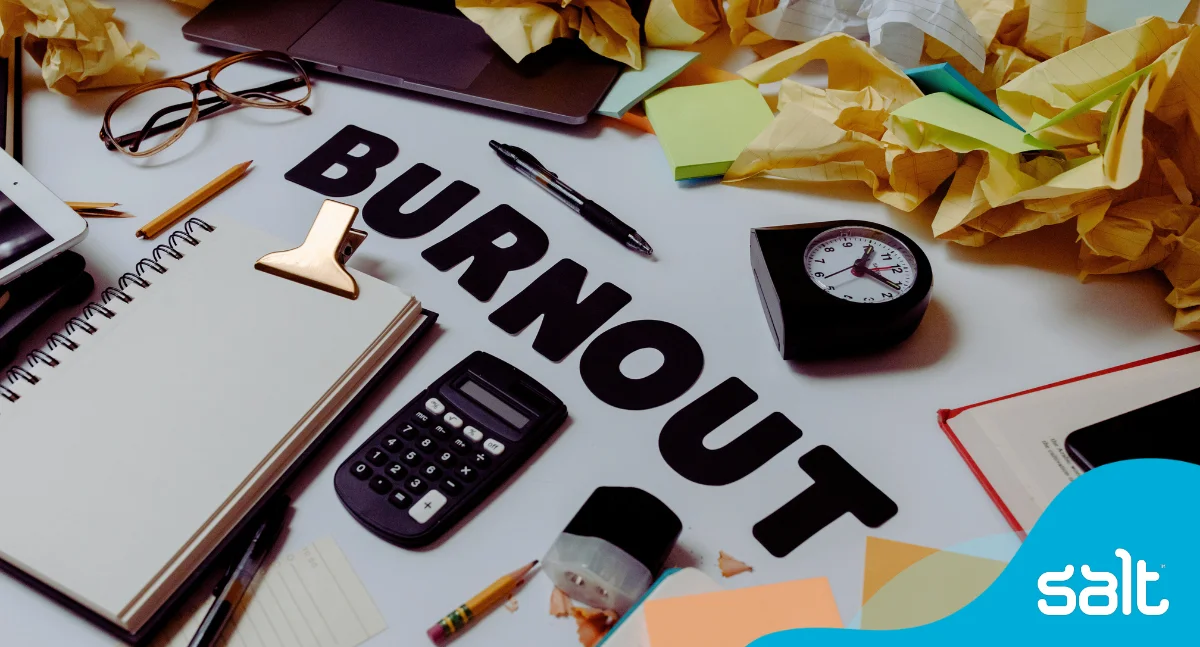
If you or someone you know is feeling tired or overworked, you are not alone. With work-related stress on the rise, burnout is a growing concern for everyone. It’s crucial to understand the cause, the symptoms and what can help cope with burnout in today’s workplace.
Worried you, your team or someone you know might be burning out? Concerned it’s impacting your work? You’re not alone. 33% of employees say they are less focused at work as a result of burnout according to research by Ceridian, while 31% report losing interest in work, and 21% report increased procrastination.
Burnout costs businesses. Employees experiencing burnout are 63% more likely to take a sick day and are 23% more likely to visit the emergency room, Gallup reports. In the US alone job-related stress contributes to 550 million workdays lost every year, and the WHO estimates that $1 trillion is lost in productivity each year as a result.
There must be more understanding of the condition and how to counter it effectively. This article charts the increase worldwide in cases of burnout, what burnout means, how to spot the symptoms and what you can do or encourage others to do in cases of burnout to manage stress and negative feelings towards work.
Cases of burnout are increasing worldwide
The increase of cases of burnout, and unmanageable work-related stress, has been dramatic since the experience of working through the pandemic. Research from Gallup and Mind amongst others show how marked this shift was: where workload, job security as well as economic and social stress contributed to poor mental health, and poor productivity for many in and out of work.
Like the pandemic, burnout doesn’t impact everyone equally. There are factors that contribute to burnout in some groups more than others – like caring responsibilities, financial security and digital habits.
Future Forum Pulse reports globally that there’s a significant gender gap in cases of burnout: female workers citing 32% more burnout than their male counterparts. Age is also a factor, with 49% of 18-to-29-year-olds saying they feel burned out compared with 38% of workers age 30 and older.
While employees of every age group are experiencing their stress levels rising, the younger generation are feeling the biggest impact according to a Cigna 360 Global Well-Being Survey of nearly 12,000 employees across 15 countries (including the UK, Australia and the US):
- 91% of Gen Z participants between the ages of 18 and 24 feel stressed, compared to 84% on average.
- Unmanageable stress impacts almost a quarter (23%) of Gen Z-ers, with 98% experiencing symptoms of work burnout.
- Millennials between 25 and 34 were close behind Gen Z, with 87% saying they were stressed.
What is burnout?
The term ‘burnout’ relates to a state of emotional, physical and mental exhaustion which is caused by excessive and prolonged work-related stress. It occurs when you feel overwhelmed, emotionally drained, and unable to meet constant demands.
The World Health Organization (WHO) has classified burnout as a medical diagnosis. It is defined as a condition in the International Classification of Diseases: “a syndrome conceptualized as resulting from chronic workplace stress that has not been successfully managed.”
What are the symptoms of burnout?
Job burnout is dangerous to both careers and people. Burnout has 4 symptoms to keep watch for – whether you’re worried about yourself or someone you know:
- Feelings of energy depletion, exhaustion and fatigue
- Increased mental distance from your job
- Feelings of negativism or cynicism related to your job
- Reduced professional efficacy
To understand what this might look like for you, you might be experiencing burn out if:
- You have little to no motivation
- You feel exhausted and drained the majority of the time
- You feel like you’re constantly on and always thinking or doing something
- You are experiencing headaches or stomach aches
- You’ve noticed that your work isn’t to the standard it used to be
These are just some of the signs of burnout. It might manifest differently for you. If any of these symptom match how you’re feeling however, take some time to reflect on how you’re feeling both inside and outside of work. Burnout has a considerable impact on your mental health – and you could find you’re feeling more anxious or depressed.
What to do if you’re feeling burnt out at work:
1. Take some time off to recover
If you’re in work and feeling signs of burnout, you might feel like you’re in fight mode for your job and that you’re too behind to take time off. But you can’t be the best at your job if you’re exhausted and haven’t had a chance to rest! Book some time for recovery, even if it’s just a day off, to regain your focus, recover your energy and do something that makes you feel good.
If you’re currently unemployed, you might be stuck at your desk trying to meet application deadlines. As hard as it can feel to take a break when you’re stressed about getting work, you need to let yourself have a day off to recover. Job searching can be disheartening and can leave you feeling deflated and drained.
To make use of your time off and stop yourself focusing on work, fill your time with things you like doing that require little or no effort or planning. It could be seeing family or friends, but it could also be quiet time alone reading or going for a walk.
2. Talk to your manager about your workload
In uncertain economic times, and in times of personal stress, you might feel vulnerable at work. This might mean you’re putting yourself forward for lots of different projects and tasks to prove your value. It might also be that the task list is just very long for everyone in your team, and you’re feeling the stress more than others.
If you’re feeling overwhelmed or cynical about your to-do list, struggling to fit everything in and barely leaving your desk – try having an honest conversation with your manager or HR team about your workload.
It could help to reframe this from a conversation about having too much on to a conversation about what to prioritise. Your employer wants you to be productive and to do that you need to feel happy and comfortable at work and with your workload. If you’re taking work home with you, and it’s in your thoughts at night and over the weekend, you can’t properly switch off and recover to bring your best in working hours. It’s much more positive to have a manageable list every week that you can feel happy about completing – than to keep worrying about all the moving parts needed in future.
3. Reframe work at a cultural level
It’s much more important to consider what you’re doing during work hours, than how many hours you’re putting in.
Gallup has recently published research dispelling some of the biggest myths surrounding burnout. While some have tried to manage stress by reducing hours, their findings reveal that working less isn’t enough.
To improve well-being and prevent burnout at work, employers and employees alike must work together to address how employees experience their workload. This has a stronger influence on burnout than the number of hours they work, and the quality of the work experience has 2.5 to three times higher impact on wellbeing than the number hours an employee works.
4. Disconnect from your digital devices
There are a lot of benefits to being in a digital world, but one disadvantage is that we are always switched on – to news, to status updates, to emails. Our brains are not conditioned to process all of that information. Infinity scrolling, and having your phone on you at all times, away can trigger negative emotions and heighten that ‘always on’ feeling, which can lead to burnout.
Start with small steps such as putting your phone away for a certain amount of time in the evening. You could also try holding off from looking at your phone as soon as you wake up in the morning by making yourself a cup of coffee or breakfast first!
You might find by being disconnected from the noise on your phone, you’ll start to feel calmer and clearer and focused on yourself.
5. Write a list of things that make you happy…
This might sound silly – but making a list of things that make you happy and that you’re grateful for can help reframe your day. It can remind you of the things you love and that make you feel good, the things you would be prioritising if not for the feelings of stress and worry around your job.
It’s also good to have a list of fail-safe things that improve your mood so you can turn to them when needed.
Visit Mind’s website for more resources on handling your mental health at home and in the workplace.
Ready to take on a new role? Find your dream job with Salt
Work with recruitment experts to secure exciting opportunities across Consulting, Creative, HR, Marketing, Sales, and Technology sectors.
To shape your future with Salt, upload your CV or get in touch with our teams!
Check out our open roles!
Take a look at the jobs we have available around the world:
- Australia
- Canada
- Belgium
- Europe
- Hong Kong
- Malaysia
- Middle East North Africa
- Netherlands
- New Zealand
- Singapore
- South Africa
- United Kingdom
- United States
Keep up with Salt’s career advice to help you on your job search! You can stay in the loop by following us on LinkedIn, YouTube, Facebook, Instagram, Twitter and Spotify.


